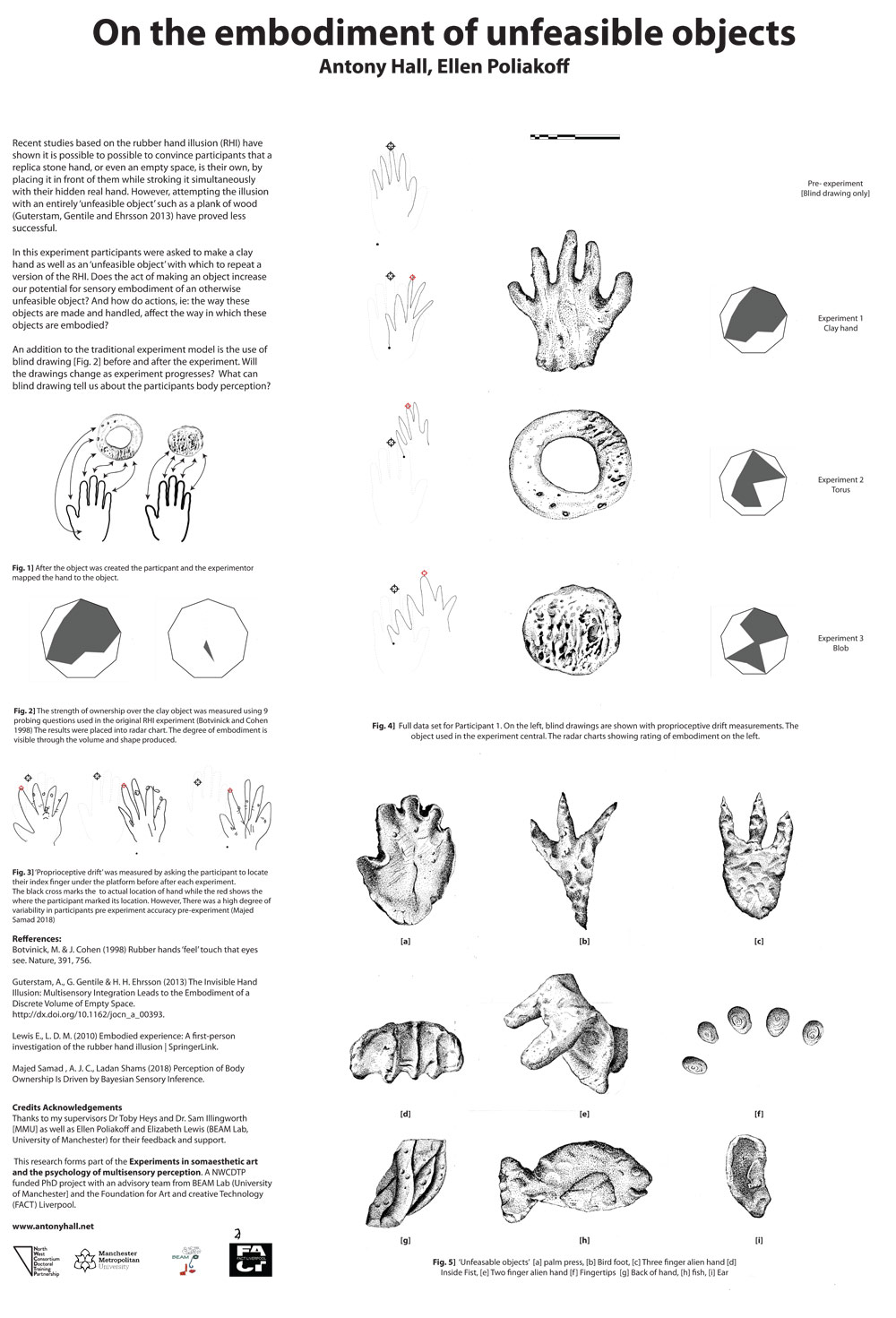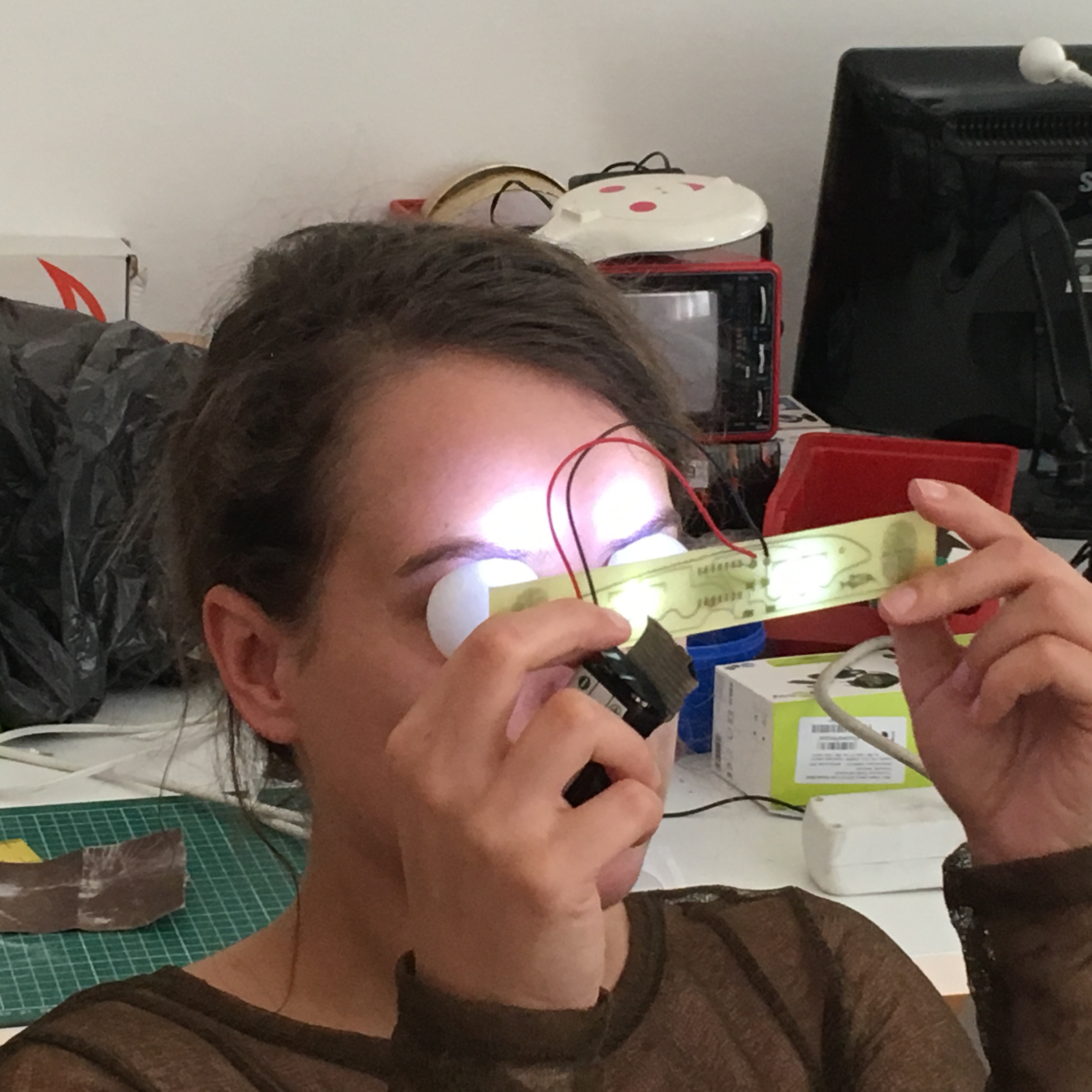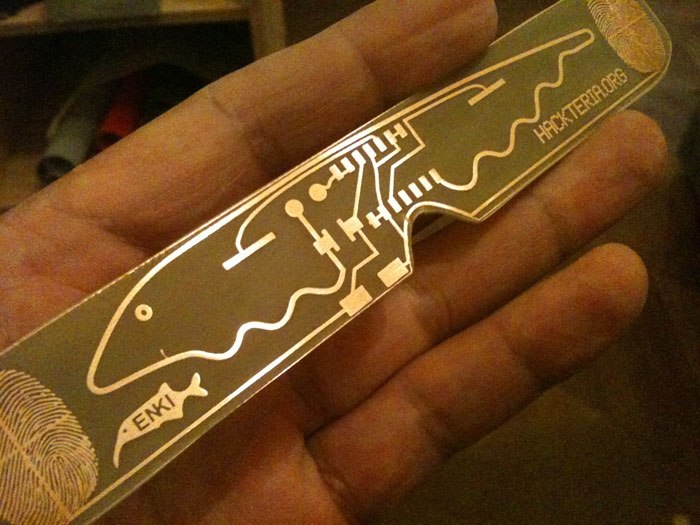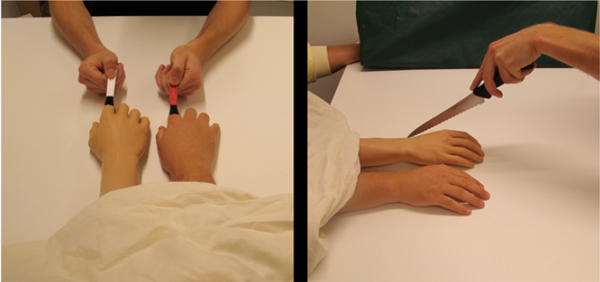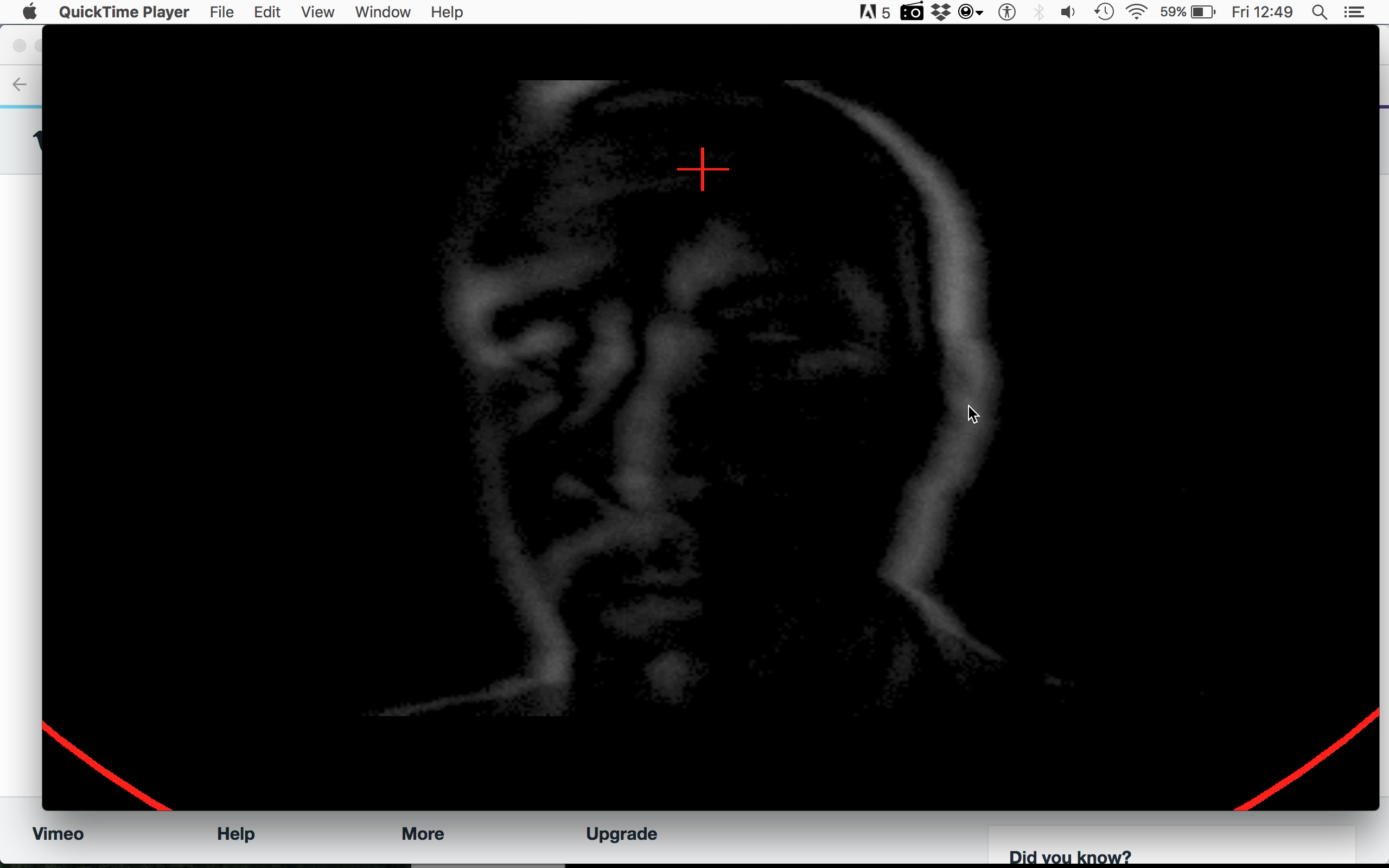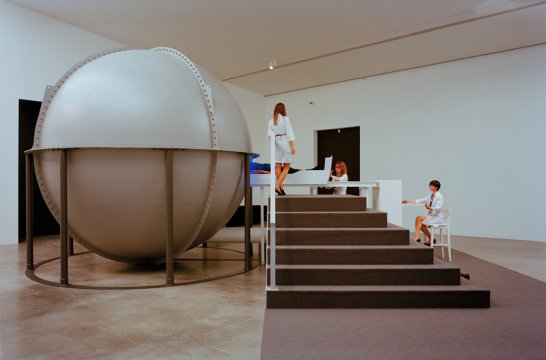The first film of the Tactile Anchoring Device in progress, showing the use of brushes and fans to generate the illusion of an invisible hand... https://youtu.be/vHaB6HBbQrs The system is based on an Arduino controls two sets of identical stimuli which move in synchronisation with each other [ servo motor, articulating solenoids, fans, lamps etc] Once the participant is experiencing the illusion, the operator or autonomous systems can trigger a ‘shock’ or threat stimuli. This is currently in the form of a solenoid which releases a heaved plum line weight which drops into the empty space. See the project page here. http://antonyhall.net/blogtactile-anchoring-device/
Tag: art
Aperture navigation
From the field research trip to the Middlewood Trust, I developed a set of goggles with a small hole and slot apertures. Participants report different perceptions of time and space, and of sound and distances. I thought I had walked for a great distance, only to find I had only moved a few meters. One participant spoke of having 'microscope eyes' and how 'the closer you get to things, the less you can see of them' focussing and depth of field also become more apparent. Here is the extract from my experience: "Seeing through the small aperture also had the effect of making things seem like an old movie [grainy and soft-edged]. After wearing these for a while, I could hear others
Navigations
The Ganzfeld [ 'total field' ] experiment is a form of perceptual deprivation, giving an experience of a uniform field of light [More information here] . has become a staple activity in my workshops. Rather than sitting still and listening to sounds I have been opening this up as a mobile activity, or 'navigation' as I have started to call it. It serves as an icebreaker, often requiring people to work in pairs to move through spaces, following ropes or sonic stimuli. The purpose is to heighten the participant's awareness through altering their perceptual experience of space. Participants become aware of new structures of light or start using the body in a different way in order to move, becoming more
Lenticular goggles
Speaking with an artist while making plans for a future Action Lab, I came up with the idea of making these lenticular glasses [Above], which use a lenticular lens [textured with lines or ridges] which have the effect of dividing the visual field into lines. In an urban or interior space, vertical and horizontal lines are common. These become enhance or reduced depending on the orientation of the lens. Using the lens in a vertical alignment, steps become invisible, but when the lens is rotated they become enhanced. Using a combination of both things get even stranger. Point light sources create strong bright lines. I have yet these in a natural environment.
Fieldwork / Night walk
I teamed up with artist Annie Carpenter to pull together a small group of artists and friends for a night of ‘fieldwork’. We organised an overnighter to do some experiments and have discussions together in the relaxed atmosphere of Middlewood Trust study centre; an off-grid permaculture farm. I had worked here before with [Annie and Sam Illingworth] doing some workshops with their students on a previous 'field research' style project. The concept captured my interest. We wanted to create a situation where we could work as well as have time and space to chat about ideas with others. My equipment consisted of my laptop, Arduino, [with a relay shield for experiments] and some electronics, GoPro, 360-degree camera. Also a heavy rechargeable
Tactile Anchoring Device Prototype 1
Here is my prototype device intended to help autonomously generate the 'invisible hand illusion'. For this experiment, I created a series of brushes which rotate at different speeds stroking empty space. The idea was that the participant watches this device, while the brushing motion is replicated one their real hand hidden nearby. This is building towards a piece of work called 'On the embodiment of a discrete Volume of Empty Space' [ See http://antonyhall.net/blogtactile-anchoring-device/ ] https://www.youtube.com/watch?v=DI-f6KgRD2w&w=700&h=400
Augmented senses
In this experiment, they created a simple device [Hearspace App] incorporating a compass and headphones. It "allows users to reliably hear the direction of magnetic North as a stable sound object in external space on a headphone. They found that "long-lasting integration into the perception of self-rotation. Short training with amplified or reduced rotation gain in the magnetic signal can expand or compress the perceived extent of vestibular self-rotation, even with the magnetic signal absent in the test" I was struck by this statement "sensory substitution and augmentation research has aimed to restore sensory functionality from non-invasive afferent signals of artificial sensors...there has been little concrete evidence that truly perceptual experiences have ever been obtained via this approach" Sensory augmentation: integration of an auditory
“On the embodiment of a discrete volume of empty space”
As I mentioned before [Illusions of Invisible, alien hands, 3 arms, and shrinking bodies…] The Invisible Hand Illusion is a version of the Rubber hand illusion which uses no fake rubber hand at all. Instead, the participant focuses on an empty space in place of their hand. Sometimes a handless stump, and as a control, a wooden plank. they found that participants could embody a ‘Discrete Volume of Empty Space’. This interests me as it fits with a number of works which challenge the physicality of the art object, instead, I have presented amorphous forms of bubbling materials or even a plinth which automatically concealed the object. The idea of making an automated system to generate the illusion of an invisible hand seems the next step for my research.
Poster – BRnet Conference 2018
Electronic Taste Perception Workshop – Radiona
[Here is some documentation from one of the activities for the 're-mapping the senses workshop earlier this year...] Our sense of taste is directly affected by the colour and smell of the food. Experiments prove that the colour of a drink affects our perception of its sweetness for example. Altering the sound of the food, say adjusting the high-end frequencies while eating crisps can also affect our perception of the crunchiness of those crisps [see the paper here. Playing with these assumptions and expectations can create heightened food experiences. There have been a number of studies that suggest it is possible to simulate Sweetness, bitterness, sourness. Specifically, we test these settings as claimed by the Vocktail project [see below] to simulate the following sensations... Sour: magnitude of current: 180
Making Immersive Experiences
“ What do new immersive technologies, such as augmented reality, virtual reality and artificial intelligence, offer storytellers and makers? And do they change the stories we choose to tell audiences? Two internationally renowned digital storytellers and makers present their latest creative projects and help us to find answers to these questions.” Notes from 'Making Immersive Experiences 1: Lance Weiler, Storytelling Lab, Columbia University + Chris Mullany, Marshmallow Laser Feast' Organised by Immersion Research Group, Manchester Metropolitan University Immersive storytelling is not something I have really ever thought about in relation to my work, however, I find the ideas discussed resonated strongly with my own practice and collaborations I have been part of. While listening to the speakers I realised I have taken part in
VR technology
Some notes and links, reflecting on the VR mask. The absurdity of the interface is both clumsy and undignified technology orientated experience.... https://www.youtube.com/watch?v=NtwZXGprxag The Sword of Damocles 1968 was the first HMD unit, invented by Ivan Sutherland. https://www.youtube.com/watch?v=gWLHIusLWOc "The intention of Birdly® is to fulfil people’s ancient dream of flying. With virtual reality (VR) and robotics technology, SOMNIACS creates an extremely vivid full-body experience that makes you instantly forget the mechanics and computer codes behind this spectacular apparatus. The immersive and interactive nature of Birdly® serves one goal: to enjoy the ultimate freedom of a bird and intuitively explore the skies." http://www.somniacs.co/ https://www.youtube.com/watch?v=qh2UdRKNqH4
Drawing the unfeasible objects
I chose to draw each clay object created for the unfeasible objects experiments. Why? The photographs don't seem to do justice to the significance of the object, its purpose and the process its undergone. Both with my self and the participant. They say drawing itself is a form of embodiment. "In the gesture of a drawing, there abides the question of how human beings hold memory. A trace of the body, the projection of an emotion, a record of the experience of seeing are woven into the gestured mark, a kinetically vitalized inscription that can serve as a site of empathy and invitation as much as a line of mimetic description" Marking Time, Figuring Space: Gesture and the Embodied Moment. Sara Schneckloth The
Proprioceptive drift visualisation
[wpvideo VartTqKO ] My experiments show a strong ‘drift’ in the perceived location of the hand before and after the experiment. This is known as proprioceptive drift. I asked people to locate the position of their index finger under a platform before and after embodying a clay object. And also draw their hand without looking before and afterwards. This animation shows these superimposed, illustrating the drift away from the real location of the hand.
Fish-brain-machine / Radiona workshop
After constructing the Fish-brain-machine PCB circuits we spent some time experimenting and describing the hallucinogenic visuals created by the stroboscopic light. The ping pong balls over the eyes diffuse the LED light, making for a more intense effect - and enabling use with eyes open. Here they describe some of the effects including seeing colours and 'a strange experience' of seeing with only one eye - I get this exact same feeling when using it. It is also hard to know if your eyes are open or closed. [See also Re-mapping the senses workshop ] https://www.youtube.com/watch?v=Lwne5xICLkI
Radiona workshop, Zagreb
I'm doing a workshop related to my research, perceptual illusions and altering perception through experiments, Clay hand illusion and other activities based on sound and light and taste, at Radiona Zagreb, 21-22/04/2018 https://radiona.org/ check out the web Re-mapping the senses workshop page and resources here...
Fish-brain-machine
As part of my Enki exhibition at Kapellica Gallery in Ljubljana 2012, I developed a related perceptual illusions and brain hacks workshop with Marc Dusseiller [Hackteria], as part of the gallery’s Biotech program. We came up with the idea to make a special issue circuit for the workshop and we set to work designing a circuit the encapsulated the Enki project in miniature. After a couple late nights, we came up with this super cool PCB design. Marc worked hard to create a fully functional efficient design, which was also aesthetically pleasing. The outline of the fish is also the ground in the circuit. This has to be the most ultra minimal brain-machine available to build. 6 components. We spent further
Strange face illusion with two-way Mirror feedback
“… a quiet room dimly lit by a 25 W incandescent light. The lamp was placed on the floor behind the observer so that it was not visible either directly or in the mirror. A relatively large mirror (0.5 m60.5 m) was placed about 0.4 m in front of the observer. The luminance of the reflected face image within the mirror was about 0.2 cd mÿ2 and this level allowed detailed perception of fine face traits but attenuated colour perception…The task of the observer was to gaze at his/her reflected face within the mirror. Usually, after less than a minute, the observer began to perceive the strange-face illusion…” Giovanni B Caputo, Perception, 2010, volume 39, pages 1007 – 1008 2010
Mechanically Augmented Reality
When I first learned about the Rubber hand illusion [RHI] I immediately began to think about ways in which the process could be automated to create an artwork, in which the experimenter's presence was removed. This could be done using sensors and a microcontroller to articulate solenoids to tap fingers for example. That thought train was on a back burner until discovered the work of fellow MMU PGR Lin Charlston. As part of her PhD research [See her profile here 'The Multimodal book as organism, artefact and assemblage: non-human agency in processes of growing and making'] She invented a beautifully simple, entirely mechanical device just to do exactly this. Your hand is placed inside a box, while the other hand turns a crank. On top of the box, another rubber hand
On the embodiment of unfeasible objects
Further to my last post detailing experiments relating to the embodiment of invisible and even third hands, here are some notes on my first 'Clay hand Illusion' experiments... The ‘Rubber hand illusion’ shows it is possible to convince participants that a rubber hand is their own by placing it in front of them while stroking it in the same way as their hidden real hand. The use of self-made clay hands, or objects [see below] in place of the rubber hand raises several interesting possibilities for exploration, which move away from the embodiment of replica body parts, and towards the possible embodiment of modified body parts, or completely 'unfeasible' objects.The clay allows for the gradual and immediate morphing of forms and for the
Illusions of Invisible, alien hands, 3 arms, and shrinking bodies…
I have previously posted about the original 'rubber hand illusion' in which participants are convinced a fake rubber hand is their own. A classic low tech experiment that can help us "understand how sight, touch and “proprioception” the sense of body position, combine to create a convincing feeling of body ownership, one of the foundations of self-consciousness (Nature 1998, vol 391, p 756 )” Further to this research recent studies have gone on to experimentally induct of out of body experiences or create body swap illusions. [ Henrik Ehrsson and Olaf Blanke http://www.eurekalert.org/pub_releases/2007-08/ucl-foe081407.php ] Between these two experiments, several interesting versions of hand-related experiments also exist which demonstrate the plasticity of our body perception... The Alien Hand Experiment first created in the 1960s predates the Rubber hand experiment, seems more 'trick'
Blind drawing of hand
Blind drawing of hand starting from the left and using a continuous line, before and after experiments. Could this exercise be used as a measure of "proprioceptive drift" before and after 'Rubber hand illusion' type experiments? I will be exploring this idea soon with the research group at BEAM lab...
Face as Interface
Trying to create a simple motion tracking patch using PD_extended and Gem, I came across this project by Elektro Moon Vision http://elektromoon.co.nr/ the mini App provides OSC data from movements such as eyebrows, nose, mouth, orientation scale etc. This is massively useful for an experiment I have in mind related to the "strange face in the mirror illusion" The data can be captured and used to control a 3D model in virtual space for example. Matching rotation, scale and orientation to the model and the movement of my head... This is a simple motion detection patch that tracks the difference between two frames creating ghostly outlines of momentarily disembodied features. It's sensitive enough to pick up facial expressions such as the movement of muscles and
Drawing a strange face in the dark
Shortly after my experience of the "Strange face in the mirror experiment" I made these drawings in low light conditions as a way of recording the perceivable elements of my face and shape of the head. The particles of carbon and graphite reflect well the visual noise, like static, one experiences in the experiment. These drawings don't illustrate the hallucinations I experienced [these will follow] "staring at one's own reflection in a mirror in a darkened room for some time can induce vivid hallucinations. For purposes of research, I had to try it" My experience of the ‘strange face illusion’... For my description of my experience of the 'strange face', illusion see here... "staring at one's own reflection in a mirror in a darkened room for
Mixing object actions and context
This research looked at how we respond to the observation of actions and how the context affects our neural processing of that action. I was fascinated to learn simply by observing an action with an object that can be potentially used for an action - such as a potato peeler - the brain seems to simulate this action. But what happens when we observe an object being used for an action in an unusual context? Or what happens if we see an object being used for an unusual action, perhaps even in an unusual space. The experiments used videos of a person performing a task with specific objects in specific contexts such as cracking and egg into a bowl in the kitchen. and was then repeated in
James Turrel – Light Reignfall
[vimeo 75419053 w=640 h=360] James Turrell's Light Reignfall @LACMA - Andrew van Baal James Turrell's Light Reignfall Light Reignfall is a work from his series of perceptual cells, inside the participant is exposed to a uniform homogenous field of modulated light. A combination of sensory overstimulation, yet deprived of recognisable forms or space, hallucinatory effects are experienced. “Assisted by an attendant, an individual viewer enters a spherical chamber on a sliding bed. A program of saturated light (operated by a technician) surrounds the viewer for twelve minutes, allowing the visitor to experience the intense, multi-dimensional power of light and the complex seeing instrument of the human eye.” "James Turrell (b. 1943, Los Angeles), a key artist in the Southern California Light and Space movement
Notes on olfactory art
Olfactory art or Scent art has been growing over recent years, And I would agree with the premise, that 'it has been long disregarded as one of the lower senses' [scentart.net] I remember turning up for the opening of my own exhibition and discovering that along with the beverages, a selection of delicious snacks had been presented on tables placed inside the gallery space. The smell of the food filled the gallery and I felt at the time that this took away from the work. The smells that would have accompanied the work would have been, hot electronics and detergent. perhaps a hind of coffee from another experiment. Here are a few links to useful sites/research on the subject: "The sense of smell has long been
What is Somaesthetics?
The work of Olafur Eliasson and Carsten Höller are prime examples of artists working with perceptual systems in which the viewers become active participants. This could be called 'Perceptual Art' but this term is not widely used, and it has been in a limited sense referring to artwork using optical illusion. In light of this, searching for an umbrella term for artwork that uses experiential and multisensory elements, I stumbled across the term 'Somaesthetics' "an interdisciplinary field whose roots are in philosophical theory, somaesthetics offers an integrative conceptual framework and a menu of methodologies not only for better understanding our somatic experience but also for improving the quality of our bodily perception, performance, and presentation " [1] first coined by Richard Shusterman in 1996 There is
Acupuncture, brainwaves, and electric fish
Some documentation from a day working with Greg Byatt developing a system to work with the IBVA [Brainwave visulisation] interface. Such as attaching the Electric signal discharge output from the Electric Fish to acupuncture pads placed on our arms, to see if we could perceive the signal and also seeing how the fish behaved. No conclusive results. More time needed! In preparation for the next Enki event, we spent the day testing the neuro-graphic interface; as an experiment, we patched a strong frequency via MIDI to a MAX patch so our brains were modulating all kinds of strange sounds. Later this will combine with the Enki interface as a form of feedback. In this image you can see the graphics of the brain activity and
Enki Manchester Science Museum
Some of the early experiments for the Enki project at Museum of Science and Technology Manchester 2007... We recorded brainwave data and monitored the behaviour of the electric fish during the experiment. The electrical activity of the fish is experienced as sound and light via ENKI (a stroboscopic high frequency led placed close to eyelid) and the natural binaural frequencies produced by the interaction and communication between Black Ghost Knife fish. The participant's bio-electric field was connected to the aquarium allowing the fish to sense a human (bio)electric image or presence. Museum of Science and Industry Manchester, 7th October 2006




